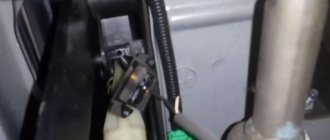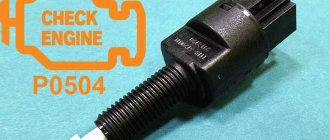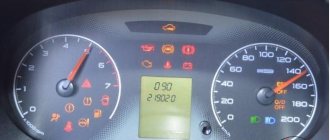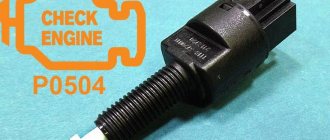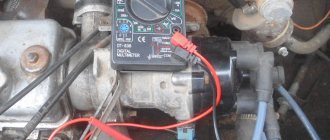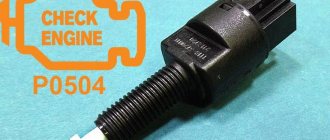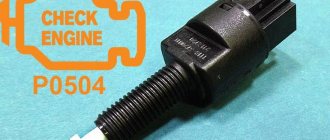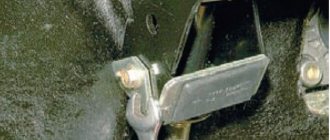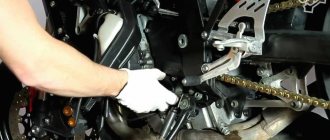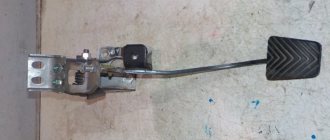Hi all. Today we'll talk about the brake pedal sensor, or brake pedal position sensor to be precise. You will learn about the weak points of this device, as well as how to repair the brake pedal sensor or replace it on a Lada Granta.
Increasingly, “Grant drivers” began to encounter problems related to the brake pedal sensor, which is installed on the Lada Granta with an electronic gas pedal. The problem appears in the form of a burning “CHECK”, as well as error P0504 (mismatch of brake pedal sensors). This phenomenon may be accompanied by unstable engine speed, poor starting or stalling of the engine.
The sensor that will be discussed in this article combines two functions at once: it is a brake pedal position sensor and a stop switch. A common failure of this sensor is a broken spring, problems with the wiring or contacts, or misalignment of the sensor.
Video “eliminating squeaks”
You can learn how to solve one of the problems associated with the clutch in a car from the video from the author Konstantin Biyanov.
Replacing the Priora clutch sensor
Clutch sensor on Prior
Priora clutch sensor
Clutch sensor or Error P0830 on Lada Granta
Lada Granta - Error p0830 Clutch sensor malfunction
Clutch sensor or Error P0830 on Niva 21214
PRIORA clutch cable
Installing clutch sensor, 6Q0 927 189
CLUTCH PEDAL LIMIT ON NIVA. Repair or replacement #AutoFormula 4x4
Clutch pedal clicking PROBLEM SOLVED
The widespread computerization of cars, adapting to consumer demand, non-stop pushes the best engineering minds to new discoveries. Every year, driving cars becomes more comfortable and safer - and all this thanks to all these innovations. Today we will talk about such an element as the clutch pedal sensor.
There are two versions of the clutch sensor, which are not fundamentally different from each other - one is used in a robotic gearbox, the other in a manual one. What does the clutch sensor do? The answer is quite simple - the electronics send a signal to the control unit so that it, in turn, synchronizes the rotation of the engine crankshaft and the gearbox input shaft.
Brake pedal sensor for Lada Granta
What is a brake pedal sensor, what problems can arise with it and how to fix them yourself. You will learn about all this below.
The introduction of updated standards regarding the level of toxicity of exhaust emissions from vehicles into the atmospheric air has created conditions for the development of new engine control devices by the Volzhsky Automobile Plant.
In addition, a brake pedal sensor appeared on Lada cars, including Grants. But many car owners, after using their car for a very short time, begin to notice error P0504, signaling a breakdown of this element. Let's try to understand this issue in more detail.
Solving the problem through the use of alternative spare parts
Since domestic spare parts do not save the situation, you can resort to using others, namely the brake light switch (FACET 7.1126) for Volkswagens. Such a switch is slightly more expensive than a Lada Granta brake pedal sensor, namely 560 rubles. The device is of a similar type and has:
• threaded leg with a similar diameter of 12 mm.
The only thing you need to use FACET 7.1126 is a terminal adapter.
Performance diagnostics
The functionality test consists of: 1. In testing (checking) the product with a multimeter.2. Disassembly and visual inspection of the internal components of the part.3. The replacement sensor is not known to be good.
The first method involves alternately measuring the contacts of the dismantled sensor. The point is to check each contact individually and in pairs (second and third contact). This is quite convenient to do, since at the place where the contact chip is connected, all connectors are numbered.
The second method is used to identify faulty or deformed internal elements of the product (in most cases, damaged springs). Remove all internal elements and pay attention to their integrity and performance. In addition to the condition of the springs, pay attention to the metal contact plate. There should be no traces of oxidation or contamination. If there are any, clean them out.
The third method is quite simple and trivial. Install a new part to replace the one whose serviceability you doubt. Test the operation of the car by driving in various modes, when switching up and down gears. When the system is restored to normal operation, the malfunction indicator (check engine) should go out (if it does not disappear within 15 minutes, the error should be reset manually).
Cigarette lighter fuse on Priora: how to replace it yourself
Some people consider the cigarette lighter a completely unnecessary thing in the car. But drivers who keep up with modern technical progress have been using it to their full potential for a long time.
Using this device instead of an ordinary outlet, you can easily connect and use various devices and even appliances to the electrical power of your car. Thanks to modern technologies, you can sit in your car and comfortably drink coffee prepared with your own hands in a portable coffee maker, all in the same car.
Where are the fuses located in the car?
In a Lada Priora car, the cigarette lighter fuse is installed in the mounting block. To find it, the driver sitting behind the wheel inside the car just needs to look down and to the left.
The relay and fuse box is also called the mounting block or black box. In the event of a car breakdown related to electrical equipment, the fuses and relays are first checked. If a fuse is blown, you must first determine the cause of its blown before replacing it.
- The main mounting block of the Priora is closed with a lid and located at the driver’s left foot. To open it, you need to turn three latches 90° and unclip the lid.
- The fuse box is under the hood, which is located near the expansion tank.
- Another mounting block, which is located near the left foot of the front passenger. To gain access to the fuses and relays, unscrew several screws with a Phillips screwdriver.
If you look at the diagram, you will notice that the cigarette lighter fuse is designated F13
What devices can be connected to the cigarette lighter?
Knowing the current rating for which the Prior's cigarette lighter fuse is designed, you can calculate what power devices can be used. To do this, we multiply the current strength of 15 A by the rated voltage in the cigarette lighter - 12 V.
We find that the power of the connected devices should not exceed 180 W. And the list of devices is very wide, because technological progress does not stand still, making the life of the driver and his passengers much more comfortable. Here are some of them:
- Compressor;
- Air purifier and ionizer;
- Electric kettle or boiler;
- Fridge;
- Massage cover or pillow;
- Navigator, video recorder, etc.;
- Seat heating pad;
- Lamp or lantern;
- Fan;
- Vacuum cleaner;
- Splitter.
Let us additionally note that every year various new devices and all kinds of instruments appear. Always be careful about what you connect to the car cigarette lighter, because excessive load can not only cause fuses to fail, but also a short circuit, and worst of all, a fire.
Common faults
Like any other electromechanical device, the Priora cigarette lighter tends to break. Sometimes this can be caused by design defects, sometimes by malfunctions in the machine's on-board circuit, and sometimes by the fault of the user himself. Common cigarette lighter malfunctions include:
- sinking of those same bimetallic “ears”;
- burnout of the spiral;
- broken contact in the connector;
- fuse blown.
Malfunctions can also include the burnout of a backlight lamp, however, this is more related to a decrease in the level of comfort than to serious breakdowns. In addition, it does not in any way affect the operation of the device itself and can be easily eliminated by replacing the lamp.
The sinking of the lugs is characterized by the lack of fixation of the cartridge in the pressed position. It can be caused either by the low quality of the metal from which they are made, i.e. defect, or high intensity or long period of use of the cigarette lighter.
The problem is solved by bending the “ears” inward using a thin screwdriver, naturally after de-energizing the on-board circuit. If after a short period of use the problem occurs again, it is better to replace the cigarette lighter.
When the spiral burns out, the cartridge is fixed when pressed, but does not heat up. The fault is diagnosed by ringing it using a car tester. It is not recommended to restore the spiral, as this may lead to a decrease in its resistance, which will make unwanted adjustments to the operation of the on-board circuit. In this case, the cigarette lighter also needs to be replaced.
Contact failure can be easily determined by removing the tunnel lining and checking the condition of the connector. This malfunction is not critical and can be fixed independently in a few minutes.
But as for the fuse, it makes sense to consider this malfunction separately, since its malfunction is most often caused by the human factor.
Which fuse is responsible for the operation of the cigarette lighter in Priora
Knowing where the cigarette lighter fuse is located on the Priora, you can replace it without any problems. Service in auto repair shops is now quite expensive, so let’s figure out how you can do it yourself.
The most important condition is that you cannot install any home-made devices, such as, for example, wire or a paper clip, instead of the fuse. In addition, it is better to use domestically produced protective elements and not buy Chinese analogues, as they are of low quality. None of this is safe and can even lead to a fire.
Replacing the Priora cigarette lighter fuse is not very difficult. To do this, there is no need to dismantle its seat or the block itself. It is enough to simply replace the faulty element with a new one. However, you still need to understand the algorithm, as there are some peculiarities.
Step-by-step instructions for replacing the cigarette lighter fuse in the mounting block
To replace the cigarette lighter fuse on a Lada Priora, follow these steps:
- First of all, we have a preparatory moment. To do this, you need to turn off the ignition completely and disconnect the battery. How to proceed? Remove the negative terminal.
- You already know where the mounting block is. It is secured with 3 bolts, they can be easily unscrewed.
- After removing the bolts, the cover must be hooked from below and carefully removed.
- As mentioned earlier, the safety element responsible for the operation of the cigarette lighter is located in the top row, and at the same time on the far right. Even if you have determined its location, to be completely sure you need to check the block cover. Marking of element F13.
- There are special tweezers located in the block body (marked 1 and 2, respectively). Gently squeezing the fuse with tweezers, remove it. You are more likely to see a broken thread or that the device has melted. In some cases, a failed element has no visual damage at all.
- Install the new element into the seat. Check the fuse rating, it should be 15A.
- Replace the unit cover and secure it.
- Connect the negative terminal of the battery.
How to replace the cigarette lighter fuse in the engine compartment - step-by-step instructions
To replace the cigarette lighter fuse in the engine compartment, follow these instructions:
- Turn off the ignition and disconnect the battery.
- The main fuse box is located next to the battery. Find, checking the diagram, the element marked F3.
- Remove the faulty fuse in the same way as the previous algorithm. Install a new element with a current rating of 60 A.
- Connect the battery.
Enjoy life and take advantage of new technological advances. But do it wisely by choosing the right devices that suit your Lada Priora car.
Clutch sensor replacement
Replacing the clutch sensor on robotic gearboxes is a rather labor-intensive process, which often requires subsequent adjustment of the clutch using special equipment. Therefore, the process of troubleshooting is individual for each type of gearbox.
Replacing the clutch sensor on cars with a manual transmission, as a rule, will not take much time and effort. The clutch pedal sensor is usually located directly next to the pedal itself - with a standard set of tools on hand, you can easily replace it.
The clutch pedal sensor itself is not a complex mechanism, so adjustment is not difficult, and the cost of replacing it yourself is not at all high. The average price in auto stores is from 300 to 700 rubles.
Instructions for replacing the brake controller
- Pump out the liquid.
- Place the vehicle on a support stand and remove the wheel.
- Use a wrench to unscrew the two wheel pins.
- Remove the brake drum.
- Then, using a screwdriver, pull out the hook of the upper tension spring and remove the part. Perform the same manipulation with the lower tension spring.
- Then remove the front pad and spacer bar, while disconnecting the pressure spring and lower the pad.
- Remove the shoe lever from the parking brake hole, straighten the cotter pin and remove it from the parking brake drive.
- Remove the washer and lever.
- Install a new block and assemble the part in the reverse order.
Checking brake pad wear
We check the degree of wear of the brake pads of the front brake mechanisms in the following sequence.
1. Place the car on the inspection ditch.
2. Remove the front wheels.
3. When checking the pads of the left brake mechanism, turn the steering wheel completely to the left, and when checking the pads of the right brake mechanism, turn it to the right.
4. Through the inspection hole in the movable caliper bracket, we visually determine the thickness of the brake pads.
If the thickness of the lining of at least one pad is less than 1.5 mm, we change all the brake pads of the brake mechanisms of the right and left wheels.
5. At the same time, we check the mobility of the brake cylinder pistons. If the piston becomes sour, replace the cylinder.
To check the degree of wear of the rear brake pads, you will need a flashlight.
1. We prepare the car for work.
2. Using a slotted screwdriver, remove the rubber plug for the inspection hole in the support shield of the rear wheel brake mechanism.
3. Light the inspection hole with a flashlight. If the thickness of the brake pad lining “ A ” is less than 1.5 mm, change all the brake pads of the brake mechanisms of the right and left wheels.
4. Install the plug in place.
Clutch position sensor malfunctions
The following symptoms may indicate a malfunction of the clutch pedal position sensor:
- car “pecks” when changing gears
- a sharp increase or decrease in engine speed when the clutch is disengaged
Also, if a malfunction occurs in the clutch pedal position sensor, error 0830 “Clutch pedal sensor error” is recorded in the engine controller and the “Check Engine” light in the instrument cluster turns on.
Error 0830 is detected if the engine controller does not receive a signal from the clutch sensor:
- within 2 seconds after changing gear while driving
- after four gear changes at speeds above 10 km/h and engine speeds above 1000 rpm
The main reasons for error 0830:
- malfunction of the clutch sensor itself
- short circuit or open circuit
- Incorrect clutch pedal height
We encountered error 0830 while preparing the material “How to get there without a clutch?” We recorded video instructions on how to change gears without a clutch. After several gear changes without disengaging the clutch, the “Check Engine” light came on on the panel, which went out only after several dozen gear changes in normal mode.
Clutch sensor price
On many VAZ cars with an electronic gas pedal there is a connector for this sensor, but there is no sensor itself. It is not clear whether they forget to install it at the factory, or whether careless dealers remove it. The second option is also quite possible, since this sensor is still in great short supply. It costs an average of 350 rubles, but finding it on sale is almost impossible.
There are two types of clutch pedal position sensors for VAZ cars:
21214-3720020-02 for Lada 4×4 cars with electronic gas pedal
1118-3720015 for Kalina, Grant and Priora cars with an electronic gas pedal.
They are not interchangeable with each other.
It would seem like a simple sensor, but how much it can complicate the life of an ordinary car owner.
Symptoms of this part being faulty
Since this element is connected to the ECU, it reacts to its failure first of all. That is, it gives peculiar signals that are reflected on the instrument panel and are noticeable in the behavior of the Priora when driving.
- turning on the “Check Anger” light;
- twitching when starting to move;
- a sharp drop or, conversely, an increase in speed when the clutch is engaged.
There can be three malfunctions in total: a breakdown of the sensor itself, a break or short circuit in its circuit, and incorrect adjustment of the position of the limit switch on the pedal.
Attention! Only Prioras, which have an electronic throttle, are equipped with such a device. Cars with a regular throttle cable do not have one. It is also available for all-wheel drive VAZ. It must be remembered that these are two types of sensors, and they are not interchangeable!
In general, the “Check” warning lamp lights up in cases where the ECU has not received a signal within 2 seconds when starting from a stop or during four shifts on the move without a signal. Accordingly, the signs mentioned above appear.
Debugg
Alas, as practice shows, at the moment this sensor is not always on sale. But you need to remember that the most common malfunction is the separation of the wire from the limit switch contacts. And they are easy to solder. In general, first you need to visually make sure that the pedal pusher presses properly on the limit switch. Visually check the condition of the wires. And only after that remove it. This is a simple procedure. The clutch sensor is attached with only two self-tapping bolts, and it is not difficult to remove it with a short, shaped screwdriver. Well, then, on the spot, decide whether to start going to retail outlets in search of a new unit, or try to restore the old part. Well, put it in its place. After finishing work on the Priora, do not forget to reset the ECU error memory.
Depending on the position of the clutch pedal and the brake signal switch, the controller is able to distinguish the position of the pedals. In this article, special attention will be paid to the Kalina brake pedal sensor, as well as the clutch sensor.
Error p0504 or problem with the brake pedal sensor
The mileage of the car is 2500 km, and the check is already lighting up with alarming frequency. The pre-installed BC multitronic displays a message that error P0504 is a problem with the brake pedal sensor. I erase it so that it doesn’t become an eyesore, but nevertheless, the error pops up. What to do? How can I adjust/change this button?
In the photo this bastard is indicated by a red arrow. As people write, you need to play with adjusting it, which is done with two nuts. The most common thing is that people adjust so that the sensor button barely touches the brake pedal pad. In general, let's give it a spin and see. My BC immediately starts yelling as soon as I start the car, saying there is a mistake. I'll go dig around this weekend.
I noticed that the error pops up more often when you stand on the brake with the selector “D” on. I think the problem is deeper than just adjusting the sensor.
Yesterday, April 14, 2020, I was at the dealer for maintenance. In particular, he voiced hemorrhoids with error P0504. The dealer cheerfully undertook to fix everything. But he didn’t fix it, he said that we need to order a brake sensor, they say it’s defective. I drove out of the gate and wasn’t even surprised when the CHECK light came on again. And this morning the car did not start from the remote control, the BRAKES light was displayed on the key fob, which was corrected by pressing the brake a couple of times, then the car simply did not move, became dull, twitched, but after hitting the brake pedal again, everything was corrected, but then again. In general, the morning did not go well. I freaked out, went to the store and bought this damn sensor.
New Lada: Chevrolet Niva - buy Chevrolet Niva in Moscow - official dealer of AutoHERMES
Here he is, the bastard, in the photo. I went to the dealer, where they changed it for me in 25 minutes without charging a penny. On my part, the cost is 170 rubles for a purchase in a store. So far nothing lights up or jerks. I want to disassemble the removed sensor at home and see what in such a cheap and simple part for 170 rubles was ruining the life of a car worth 450,000 rubles! The truth is, I don’t know how to assemble it, the upper part is on three clips, which are very hard, I wouldn’t want to break it.
I will continue the epic with the sensor. Today, 04/24/2020, Jackie Chan’s new dachik lit up again - P0504. Yesterday I disassembled the old sensor.
What is immediately visible is that the small spring sitting on the rod is crooked. Contacts (nickels) of different heights. In pair 3-2, contact 2 rings in a dull tone, rang with a beeper, if on all the others it beeps loudly and loudly, then on the 2nd it is dull and quiet.
The crooked spring was replaced by another, equal in stiffness, as far as I could determine, and equal in length. I understand that when the brake pedal is released, the rod goes inward and presses the floating contact to the upper group; when you press the pedal, then to the lower one. The scheme couldn't be simpler. However, it doesn't work as it should! the spots were all set up, as if a small welding was working, on one spot there was a mark from the very edge, therefore the floating contact was pressed crookedly. As I understand it, it could have been welded, which sent a signal to the brain that the car was on the brakes.
Everything leads me to the fact that the sensor is made of bullshit! The lower spring is crooked, the terminals are made of poor steel, the spots are made of metal coated with something yellow, which can be removed by sanding with sandpaper. Small spring is crooked. The floating contact does not sit exactly on the patch; it has a slight play. All together will result in unstable work.
the price is almost three times more. For Foltz. Also four contacts, a leg with the same 12mm diameter and thread. I will buy it and make a terminal adapter, from round to flat, like ours.
I don't see any other way. Or from Toyota, Mazda, they also have four contacts on threaded legs, only they are shorter in themselves and a little more expensive. These are the thoughts.
As of May 12, 2020, I can’t do anything. I went on a long business trip, to a place where there is not even a highway, and only KAMAZ trucks pass on the winter road. That’s why my wife left the car, and I drive around there. Therefore, I will try to work on the sensor only when I have rare opportunities to see my family. Good luck to everyone!
How to remove and change power steering on a Priora (VAZ 2170) 1.6 2008
LADA Priora car contacted a service station was extraneous noise when the steering wheel moved. During diagnostics, a humming sound from the power steering pump was detected. Apparently its work has come to an end, or the power steering has been changed very rarely (the recommended frequency is 50-60 thousand kilometers ). You can try to simply change the fluid to the original one or try to temporarily restore the pump, but it is better to immediately replace the power steering on the Priora and not waste time. In addition, it is cheaper than buying fluid and a repair kit twice.
Which power steering pump can be installed on Priora (VAZ 2170)?
Manufacturer Article number Price, rub.
| Original | ||
| VAZ | 21103407010 | 4500 |
| LADA | 21100340700900 | 6000 |
| Analogs | ||
| MSG | VZ 001 | 3900 |
For installation, we chose a spare part from an analog manufacturer MSG with article number VZ 001.
What kind of oil should I put in the Priora power steering?
From the factory, the Priora hydraulic booster is filled with light green oil Pentosin CHF 11S , the cost of which is more than 1,000 rubles per liter. Original article 00001-7504780-00-0 (price 1200 RUR). The manufacturer recommends using only original fluid for power steering , so the manual makes a note that using a fluid other than Pentosin Hydraulik Fluid CHF 11S-TL VW52137 may lead to malfunctions of the power steering pump!
We chose the synthetic gear oil “DEXRON III AUTOMATIC PLUS” from Mannol. Article number 1 liter bottle of power steering fluid - AP10107. The average market value is 390 rubles. It can also be liquid FEBI 6161 (price 500 rubles)
How much oil is in power steering Lada Priora
For a Priora with power steering, the expansion tank will require ~0.7 liters of fluid. When the system is completely pumped and flushed, the entire liter bottle can be used.
List of required tools
- Lift;
- 13 mm hex head ;
- The ratchet is large;
- Open-end wrench for 17, 22 and 27 mm ;
- Crosshead screwdriver;
- Sprocket T25 .
How to change the Priora power steering pump with your own hands (removal and replacement)?
- Unscrew the bolt securing the side protection - T25 ;
- Move the guard to the side;
- Loosen the drive belt roller nut using a 17 mm ;
- Raise the car;
- Remove the belt from the pulley;
- Remove the pulley - 13 mm ;
- Unscrew the pump fastenings - w.
13 mm head ; - Remove the clamp of the incoming oil pipe - a Phillips screwdriver;
- Pull out the pump;
- Remove the oil supply pipe fitting - a 22 and 27 mm ;
- Remove the power steering ;
- Compare with new pump;
- Install a new pump;
- Lower the car;
- Open the power steering reservoir cap;
- Fill in 0.5 power steering fluid;
- Pump liquid through the system;
- Top up until full ~ 0.2 liters ;
- Pump until liquid stops coming out.
Torque:
- Power steering pump mounting bolt - 30-40 Nm ;
- Power steering pulley bolts - 30-40 Nm ;
- Fitting nut - 60-70 Nm .
1
Using a T25 the bolt securing the side protection. We take her aside.
2
Find the drive belt tension roller nut. 17 mm spanner .
3
To gain access to the drive belt, lift the car.
4
Remove the drive belt from the power steering pulley.
5
The next step is to remove the power steering pulley. Unscrew the 3 nuts securing the pulley with a 13 mm .
6
Remove the power steering pulley from its seat. The three power steering mounting bolts were opened. We unscrew them with a 13 mm .
7
There are three more bolts on the back of the power steering. We dismantle the fastenings.
8
Using a Phillips screwdriver, unscrew the clamp securing the inlet pipe.
9
Place a container or oil receiver under the power steering pump and drain the oil. In order for the power steering fluid to come out as much as possible, you need to manually turn the wheel left and right.
10
22 mm open-end wrench and with a 27 mm .
11
Remove the power steering pump. We compare it with the new one to see if it matches.
12
We install a new pump, connect the oil supply and return pipes.
13
We lower the car and find the power steering reservoir under the hood. Remove the cover.
14
Fill the tank full. You will need ~ 0.5 liters of power steering oil.
15
We turn the wheel left and right without starting the car engine until air stops coming out of the power steering reservoir. Turn it all the way. We put on the drive belt. Then we start the engine and immediately turn it off. Add power steering fluid ~ 0.2 liters . We do not close the tank lid. We start the car engine and turn the steering wheel left and right (continue pumping) until the fluid stops escaping.
Source: https://etlib.ru/report/1905-zamena-gur-priora
Causes of sensor malfunction and their symptoms
In most cases, the above error occurs because the sensor (frog) has not been adjusted properly. It is for this reason that the car owner notes the emergence of such problems as:
- instability of the engine: it starts poorly or stalls immediately;
- instability of speed.
The sensor combines two functions: it is both an element of the brake pedal position and a brake light switch. Most often, the malfunction is caused by the sensor misalignment already mentioned above, or by a broken spring. The problem that has arisen manifests itself by the “check” icon lighting up and error P0504 (implying a mismatch in the operation of this part).
So, we found out that error P0504 on Grants is caused by:
- malfunction of the part itself or its wiring;
- the element has not been adjusted properly;
- The ECM may need to be reprogrammed.
New Lada: Bringing up the “Lada-Kalina”: Coupe for lining | Ukraine Behind the wheel
If problems occur, you can repair the sensor yourself by changing the spring, or change the element itself.
Carrying out work on dismantling and repairing the sensor
In most cases, repairing a sensor does not take a significant amount of time and does not require the car owner to have either specific knowledge or the use of complex tools. You can do it yourself without going to a repair shop.
First you need to disconnect the negative terminal from the battery, and then move to the driver’s seat in the car. Move the front seats back as far as possible and remove the interior carpet. The sensor is located next to the brake pedal; to remove it, you will need to disconnect the clamp and the block with wires from its connector.
Carefully loosen the fastening nut and carefully unscrew the body of the part, then disassemble it. This element is a two-piece element, and both parts are held in place with latches.
There is a spring in the inside of the sensor, which is often what causes problems. Replacing a faulty spring with a new one, having the same number of turns and suitable dimensions, most often helps to eliminate the problem.
Having completed the repair, reassemble the element by performing the manipulations you performed to disassemble it in the opposite sequence, and then install it in its original place, and if necessary, adjust it. The part is tightened until the brake pedal goes down, after which it is turned 90 degrees clockwise and secured with a lock nut. As a result, with the brake pedal lowered, the switch rod will be in a recessed position, and when you press it, it will go beyond the boundaries of the switch body.
Next, start the engine and wait at least ten minutes; if the error does not appear, you have correctly identified the cause of the problem. If error P0504 appears again, adjust the sensor; if this error continues to appear, the part will need to be replaced.
Carrying out an inspection
To carry out the procedure for checking the brake pedal sensor on a Grant, you will need to turn on the ignition, and then press the brake pedal, while paying attention to the brake lights - have they come on? Then you need to release the pedal, again focusing your attention on the brake lights, which should now go out. If the brake lights do not light up, you should check the sensor itself, and also see if voltage is supplied from the battery to the wiring harness block.
When performing the test, circuit 1-4 should be in the closed position, and circuit 2-3 should be in the open position. Then press the rod, normally circuit 2-3 should close and circuit 1-4 should open.
Similar sensors are installed on other VAZ models: Priora, Kalina and others, so the solution to the problem will be exactly the same for these models.
The article uses photos from the Lada Granta French Platinum logbook.
Separate brake light does not light up
If only one brake light does not light, then the most likely problem is the lamp or poor contact in the socket. In this case, you need to disassemble the trunk trim on the side of the car where the signal is not lit. If necessary, remove the lamp unit, remove them from the sockets or holders, carefully inspect the contacts in the socket and on the lamp base.
The presence of rust, traces of oxidation (white or greenish coating), soot, as well as dust or moisture confirms that the brake light does not light due to missing or poor contact in the circuit. Cleaning the indicated areas will help eliminate the problem. To remove rust and oxides, you will need a sharp object, such as a screwdriver. It is also necessary to check the serviceability of the lamp. To do this, you can use a multimeter or the on-board voltage supplied to the lamp via wires through a fuse. The burnt-out lamp is replaced with a similar new one.
Adjusting the brake pedal sensor Kalina
If the sensor is in good condition, and incorrect operation of the internal combustion engine continues to bother you, try adjusting the product yourself. Please pay attention to the following features:
- The sensor must be screwed in clockwise until the brake pedal begins to move down. Then you will need to slightly unscrew the product and secure its position using the fastening nut.
- The result should be such that when there is no action on the pedal, the sensor rod is recessed into the housing, and when the pedal is applied, on the contrary, it is completely released from the housing.
- As for the working gap, it is adjusted using two nuts (one at the top, the other at the bottom). The adjustment is carried out using the upper nut, which is tightened, and the lower one, on the contrary, is unscrewed. The entire process is carried out until the button is completely recessed into the body when the brake pedal is applied. However, you should not overdo the adjustment; in other words, you should leave a small gap or travel margin (approximately 2 to 5 millimeters).
Plant technological instructions
P0504 - Brake pedal A/B switches, signal mismatch
Using the Lada Vesta as an example:
Code P0504 is entered if:
- the brake pedal limit switch signals “3-4/1-2” are mismatched for more than 200 seconds with the engine running in idle mode;
- or the number of presses on the brake pedal, determined by the signals of two limit switches “3-4/1-2”, differs by the value of the diagnostic threshold on a moving vehicle.
The malfunction indicator lights up on the 3rd trip after a permanent malfunction occurs.
Description of checks
The sequence corresponds to the numbers on the card.
- It checks whether code P0504 is active at the time of the request.
- Electrical circuits are being checked.
- Check the installation of the brake pedal switch.
Diagnostic information
The scan tool in Signal Monitor mode displays the pin status bit 3-4 (Brake Pedal Switch 1 parameter) and the pin status bit 1-2 (Brake Pedal Switch 2 parameter) of the brake pedal switch. The status of contacts “1-2” can also be monitored using the brake light lamps.
If a mismatch in the signals from the “1-4/2-3” switches is detected, the engine control system will operate in emergency mode until the end of the current trip.
After repair, start the engine, reset the codes and make sure there is no malfunction.
Using the Lada Granta/Kalina as an example:
Code P0504 is entered if:
- the brake pedal limit switch signals “1-4/2-3” are mismatched for more than 200 seconds with the engine running in idle mode;
- or the number of presses on the brake pedal, determined by the signals of two limit switches “1-4/2-3”, differs by the value of the diagnostic threshold on a moving vehicle.
The malfunction indicator lights up on the 3rd trip after a permanent malfunction occurs.
Description of checks
The sequence corresponds to the numbers on the card.
- It checks whether code P0504 is active at the time of the request.
- Electrical circuits are being checked.
- Adjust the brake pedal switch clearance.
Diagnostic information
The diagnostic device is in mode “1 - Parameters; 1 - General View” shows the status bit B_BREMS of contacts “2-3” of the brake pedal switch.
Monitor the state of contacts “1-4” using the brake light lamps.
If a mismatch in the signals from the “1-4/2-3” switches is detected, the engine control system will operate in emergency mode until the end of the current trip.
After repair, start the engine, reset the codes and make sure there is no malfunction.
By the way, the brake pedal position sensor can be repaired.
Keywords: lada xray sensors | Lada Vesta sensors | Lada Largus sensors | Lada Granta sensors | Lada Priora sensors | Lada Kalina sensors | 4x4 sensors | pedals lada xray | fret vesta pedals | fret largus pedals | fret pedals granta | Lada Priora pedals | fret Kalina pedals | 4x4 pedals | ECM Lada Vesta | ECM Lada XRAY | ECM Lada Largus | ECM Lada Granta | ECM Lada Kalina | ECM Lada Priora | ECM 4x4 | Niva sensors | Niva pedals | esud niva | AvtoVAZ order | universal article
1 0 0 0 0 1
Share on social networks:
Adjusting the brake pedal for Lada Kalina (VAZ 1118, 117, 1119)
Free play of the brake pedal is the travel of the pedal from its top position until the brake mechanisms begin to operate. It should be 3-5 mm.
Adjustment
1. We prepare the car for work.
2. Measure the free play of the brake pedal. If the free play value does not correspond to the required value, adjust its position.
3. Remove the wire blocks from the brake signal switch terminals.
4.
Using a 19 mm open-end wrench, loosen the locknut of the switch. The brake signal switch also serves as a stop for the brake pedal in its upper position. To reduce the free play, screw the locknut onto the switch and screw the switch into the bracket plate. To increase the free play, unscrew the switch from the plate a few turns and tighten the locknut.
| . |
5. Press the brake pedal several times and check the operation of the brake signals. If necessary, repeat the adjustment.
Checking the brake fluid level
The brake fluid level is checked periodically: daily during vehicle operation, during each maintenance, after operations to pump the brake system hydraulic drive and replace the brake fluid, when a warning lamp lights up on the instrument panel, indicating an insufficient level of brake fluid in the master cylinder reservoir.
1. We prepare the car for work.
2. Use a rag to remove dirt from the master brake cylinder reservoir.
3. Visually check the brake fluid level in the reservoir. It should be between the MIN and MAX marks on the tank body.
4. Check the degree of wear of the brake pad linings of the front and rear brake mechanisms.
5. If the wear of the brake pads is within normal limits, and the fluid level in the reservoir is below the MIN mark, then disconnect the tip of the wiring harness from the emergency brake fluid level drop sensor, unscrew and remove the reservoir cap.
6. Add new brake fluid to the reservoir up to the MAX mark (when installing the reservoir cap, the sensor float will be immersed in the liquid and its level will increase).
7. Close the tank lid tightly.
8. Connect the wiring harness block to the sensor connector.
9. Check the operation of the emergency brake fluid level sensor: with the ignition on, press the rubber lining of the reservoir lid from above. If the sensor is working properly, the warning lamp on the instrument panel will light up.
Removal and installation
Replacing the brake pedal sensor on Kalina is carried out using an adjustable wrench set to “19”. The sensor itself is located above the brake pedal under the steering column. Conventionally, the removal stages can be divided into 5 steps:
- Before starting electrical work, it is recommended to disconnect the negative wire (terminal) from the battery.
- Then you need to move into the car interior on the driver’s side. For ease of operation, it is advisable to move the driver's seat in the opposite direction from the dashboard.
- Find the location of the sensor. Find a contact chip with wires. Press and hold the 2 plastic fasteners located on both sides of the chip. Pull the connector out of the sensor connector.
- Take the wrench in your hands and loosen the fastening nut. After which the sensor can be unscrewed freely.
- The installation process is similar to the removal procedure, except that you will need to make adjustments (tuning), the process of which is described in detail in the previous section.
Checking the pedal free play
Free play of the brake pedal is the travel of the pedal from its top position until the brake mechanisms begin to operate. It should be 3-5 mm.
To complete the work you will need a ruler or tape measure.
1. We prepare the car for work.
2. Place a ruler or tape measure near the pedal and measure the distance from the floor to the outer surface of the brake pedal.
3. Pressing the pedal with your hand, lower it until we feel an increase in resistance to the movement of the pedal.
We repeat the measurements. Based on the difference between the obtained values, we determine the free play.
The presence of free play in the brake pedal ensures that after stopping braking, the pistons of the master cylinder will return to their original position, and as a result, there will be no excess pressure left in the brake hydraulic drive. When the brake light switch is set to limit rearward travel of the brake pedal, pressure can be maintained in the brake system, causing the brake pads to apply the brakes continuously.
If the free play of the brake pedal is less than the optimal value, it is necessary to adjust the position of the brake signal switch. Increased free play in the brake pedal may be caused by play in the drive mechanism. Worn parts need to be replaced. The cause of the malfunction may also be the presence of air in the hydraulic brake drive or a malfunction of the master brake cylinder. The identified malfunction must be eliminated.
